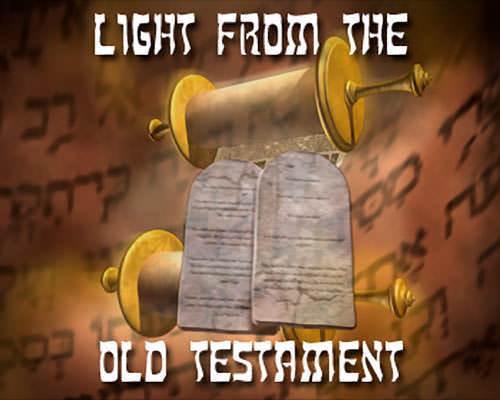
under a special agreement with

presents "Light from the Old Testament"

under a special agreement with


Lesson 10 (Part 2)
There were three beautifully colored curtains in the Tabernacle. The first one was at the gate of entrance into the courtyard. The second was at the door of the Holy Place. The third was before the Ark of the Covenant in the Holy of Holies. (See this Scripture passage: Exodus 26:31-33—click link).

The third curtain is called a "veil." The meaning of the word "veil is "to separate." This Veil told man to keep out. It told man that he could not come into the Holy of Holies, into the presence of God.
Twice a day the priests went to the Brazen Altar to offer sacrifices, then to the Brazen Laver for cleansing, then into the Holy Place to trim the lamps and to place incense upon the Golden Altar. But they did not go beyond the Veil. Only once a year, on the Day of Atonement, did the high priest go beyond the Veil of the Tabernacle and enter the Holy of Holies.
The Veil was a curtain of blue, scarlet, purple and fine white linen, with embroidered figures of cherubim, angelic beings. It was upheld by four pillars of wood, overlaid with gold, set on silver sockets. The curtain was upheld by hooks of gold.
The Veil speaks of "the flesh" or body of the Lord Jesus. The Bible says,
"In the beginning was the Word, and the Word [the Lord Jesus] was with God, and the Word was God…And the Word was made flesh, and dwelt among us…" John 1:1, 14
The four pillars upholding the Veil remind us of the four gospels which tell us of Christ's life. It is interesting to note that the pillars did not have "crowns" at their top as pillars usually have, but they were "cut off." The four gospels all tell us of Christ's being "cut off" on the cross.
Christ's holy and perfect life did not give us access to the presence of God, but His death did. At the very moment that Jesus died, the veil in the temple in Jerusalem was torn in two.

The Bible says,
"Jesus cried with a loud voice, and gave up the ghost [died]. And the veil of the temple was rent in twain [torn in two] from the top to the bottom." Mark 15:37-38
No human power could have torn this veil in two, for it was 30 feet high and 30 feet wide and a "handbreadth" in thickness [3 to 4 inches]. It was torn in two, from top to bottom, by the mighty power of God!
What does this mean? It means that, by the death of Christ, the way has been opened for believers to come into the very presence of God! We are invited by God Himself to enter the Holy of Holies by the blood of Jesus. The Bible says,
"Having therefore, brethren, boldness to enter into the holiest by the blood of Jesus, By a new and living way, which He has consecrated for us, through the veil, that is to say, His flesh…" Hebrews 10:19-20
The Holy of Holies was the dwelling place of God. It contained only two vessels—the Ark of the Covenant and the Mercy Seat, which was the lid of the Ark. (See this Scripture passage: Exodus 25:10-22—click link).

The Ark was a chest, about 3½ feet long, 2½ feet wide, and 2½ feet deep. It was made of acacia wood overlaid with gold. It had a border of gold around the top, and rings and staves by which it was carried.
The Mercy Seat, or lid of the Ark, was made of pure gold, with cherubim (angelic beings) at its ends. The cherubim covered the Mercy Seat with their wings, and their faces looked toward each other and down toward the Mercy Seat.
Inside the ark were the second two tablets of stone on which the Ten Commandments had been written by the finger of God. Later on, two more articles were kept in the Ark—a golden pot with manna, and Aaron's rod that budded.
The Ark was the actual place of God's presence among His people. It was "the throne of God." It is repeatedly said that God dwelled "between the cherubim."
There was no light in the Holy of Holies except from the glory cloud where God dwelled. This glory cloud is called "the Shekinah glory." Here, in the Shekinah cloud of glory, God dwelled with His people.
No one entered the Holy of Holies except the high priest, and he entered only one day in the year. On this day, the Day of Atonement, it was not a question of the sins of individuals. These sins were taken care of at the Brazen Altar. The question on the Day of Atonement was: How can a holy and righteous God continue to dwell in the midst of a sinful people?

On the great Day of Atonement each year, the high priest went into the Holy of Holies, carrying with him the blood of the sin offering. He sprinkled this blood once on the Mercy Seat and seven times before it. God accepted that blood on the Mercy Seat because it spoke to Him of the blood of Christ.
When the High Priest came out, he shouted one word—"Tetelestai!" That word means, "It is finished!" When the people heard this, they shouted for joy. They knew that God would continue to dwell in the midst of His sinful and failing people.
Just before Christ died on the cross, He shouted one word, "Tetelestai!"—"It is finished!" The work of redemption was finished.


